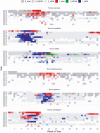Methods for broad-scale plant phenology assessments using citizen scientists' photographs
- PMID: 31993257
- PMCID: PMC6976896
- DOI: 10.1002/aps3.11315
Methods for broad-scale plant phenology assessments using citizen scientists' photographs
Abstract
Premise: Citizen science platforms for sharing photographed digital vouchers, such as iNaturalist, are a promising source of phenology data, but methods and best practices for use have not been developed. Here we introduce methods using Yucca flowering phenology as a case study, because drivers of Yucca phenology are not well understood despite the need to synchronize flowering with obligate pollinators. There is also evidence of recent anomalous winter flowering events, but with unknown spatiotemporal extents.
Methods: We collaboratively developed a rigorous, consensus-based approach for annotating and sharing whole plant and flower presence data from iNaturalist and applied it to Yucca records. We compared spatiotemporal flowering coverage from our annotations with other broad-scale monitoring networks (e.g., the National Phenology Network) in order to determine the unique value of photograph-based citizen science resources.
Results: Annotations from iNaturalist were uniquely able to delineate extents of unusual flowering events in Yucca. These events, which occurred in two different regions of the Desert Southwest, did not appear to disrupt the typical-period flowering.
Discussion: Our work demonstrates that best practice approaches to scoring iNaturalist records provide fine-scale delimitation of phenological events. This approach can be applied to other plant groups to better understand how phenology responds to changing climate.
Keywords: Yucca; anomalous flowering; citizen science; data integration; iNaturalist; plant phenology.
© 2020 Barve et al. Applications in Plant Sciences is published by Wiley Periodicals, Inc. on behalf of the Botanical Society of America.
Figures




References
-
- Ackerman, T. L. , Romney E. M., Wallace A., and Kinnear J. E.. 1980. Phenology of desert shrubs in southern Nye County, Nevada. Great Basin Naturalist Memoirs 4: 4–23.
-
- Althoff, D. M. 2016. Specialization in the yucca–yucca moth obligate pollination mutualism: A role for antagonism? American Journal of Botany 103: 1803–1809. - PubMed
-
- Barve, V. 2019. imageNat (version 0.0.1). Computer software. R Package. Website https://github.com/vijaybarve/imageNat [accessed 20 December 2019].
-
- Buyantuyev, A. , and Wu J.. 2012. Urbanization diversifies land surface phenology in arid environments: Interactions among vegetation, climatic variation, and land use pattern in the Phoenix metropolitan region, USA. Landscape and Urban Planning 105: 149–159.
LinkOut - more resources
Full Text Sources

